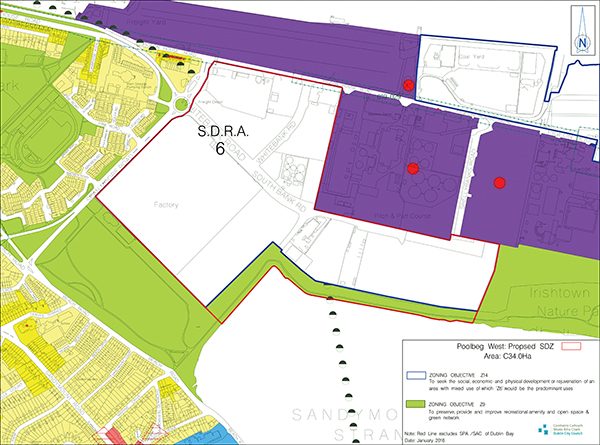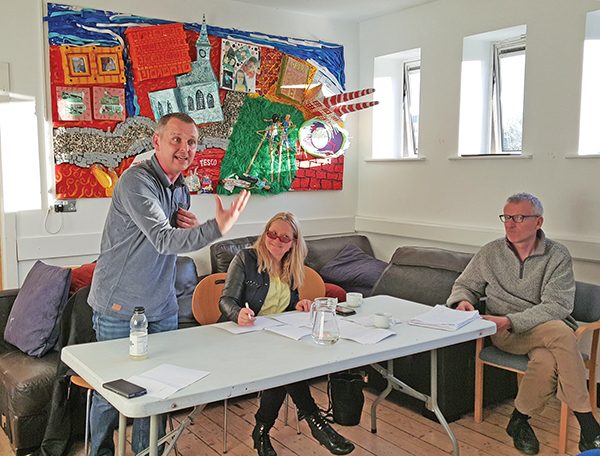
Above: The SDZ zone shown in white.
With the current state of the Irish property market, you would be hard pushed to find someone who hasn’t been affected by the housing crisis in one way or another. As rent prices continue to skyrocket and the issue of homelessness worsens every day, a solution to this problem is desperately needed now more than ever.
Across the country, a large number of development sites lie vacant, unfinished and unused, acting as a glaring reminder of our once ever-expanding property bubble, which burst a long time ago.
For many, just the mere sight of these premises is angering, and for the people of Ringsend, Irishtown and Sandymount the Irish Glass Bottle Site is a major point of contention.
The site, which was bought for €412 million in 2006, was one of the most high-profile financial fatalities of the banking collapse and was handed over to NAMA in 2012. Since then, the empty sight has lain idle, rubbing salt in the wounds of those desperately crying out for housing space in the capital.
However, a light may have just appeared at the end of the tunnel with the decision of Minister Simon Coveney TD, to designate this site, and other adjacent parts of Poolbeg as a Strategic Development Zone, meaning any development plans for the site can be fast-tracked for approval overseen by Dublin City Council and once approved the decision can not be appealed.
The site will allow for the creation of up to 3,000 new homes with an emphasis ideally being placed on the provision of “maximum social, affordable and cost rental homes,” according to Lord Mayor Críona Ní Dhálaigh. Dublin City Council say “the designation of the lands as an SDZ will also provide for a wider range of employment opportunities and social infrastructure such as schools.”
However, for the residents of Dublin 4, the issue goes much deeper than new houses and schools. It’s the chance for their children and indeed their children’s children to remain living in the area that would mean the most.
Previous to the SDZ announcement, a meeting took place in the Ringsend and Irishtown Community centre to discuss the idea of the Irish Glass Bottle site being reclaimed for the development of social housing. While the meeting was organised by People Before Profit, it was the passion of the local people that struck a chord.
In the wake of the SDZ development, an expanding group of locals have been extremely quick off the mark in setting up an action group which plans on campaigning for at least 30% or more social and affordable housing to be built on the site as opposed to the 10% proposed by the government.
The “IGB Housing Action Group,” which is being spearheaded by local representative and People Before Profit party member Annette Mooney, with the aid of Architect Mark Price, are calling for “homes for people, not for profit.”
Speaking to NewsFour about the community’s right to protest and campaign, Mooney said, “The original idea for Strategic Development Zoning came because big business elements were fed up with the planning process. People have a right to have a full discussion on how a development owned by NAMA, which was set up by taxpayers money, is used.”
The issue of a required “social mix” for the site is also an issue the action group plans to fight. “Implicit in that idea (of social mix) is that if you get a group of working-class people together, they’re going to cause trouble,” says Architect Mark Price. “What they’re really worried about is getting a whole load of working-class people together to do what we’re doing here.”
Among the many plans the Action Group are organising to further the campaign is a proposed music festival on the IGB site with potential music acts such as Glen Hansard and Christy Moore. Taking inspiration from a previous people-power success in Co. Wexford, Mooney said, “Take yourself back to Carnsore. People went down in their droves, there was a music festival and they stopped a nuclear plant from being put in place. We can make this a much bigger campaign and that’s how we will win it.”

Pictured Above : Richard Boyd Barrett speaking at the public meeting on social housing for the Glass Bottle Site.
Lorna Kelly of Sandymount and Merrion Residents’ Association spoke to NewsFour about the issue. “We’re taking it to Europe – no question,” says Kelly, explaining that if development were to go ahead on the IGB site, they would be breaching the European Framework Directives on a number of counts.
“The Irish Glass Bottle Site also has water, tar and oil tank leakage in the ground,” says Kelly. While the remediation of the ground may well be possible it would be at a huge financial cost. The horrors that may be unearthed below the land are unknown but Kelly suspects that it may range anywhere from toxic waste to animal carcasses.
“It will house lots of people who will be living in a toxic dump, on a floodplain,” says Kelly, who emphasises that this is the reason for SAMRA’s opposition and not the fact that the site will be used for social or council housing. “It has nothing whatsoever to do with that,” says Kelly. “Personally, I wouldn’t live in it and I wouldn’t accept anyone else living in it.”
Before any campaigns for housing can move forward, an expert analysis of the land will be needed to determine whether the site is even one that’s worth fighting for. However, until such a decision arrives you can be sure that the impassioned residents of Dublin 4 will continue to fight as a movement of people power spreads through the area, both for and against the development as outlined.
It is also worth noting that a paper named “Vacant Homes Paper” was recently released by the Housing Agency in which it is estimated that 40,000 unoccupied houses and apartments were known about in the capital. This certainly puts the number of potential housing units in this SDZ into context.
By Paula Bowden



